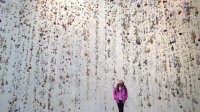Creating an Ecology of Wonder
From modeling curiosity to exploring big questions, check out these five tips for using art to cultivate imagination and wonder in your classroom.
Your content has been saved!
Go to My Saved Content.If we were to look at our schools and communities through an ecological framework, we can say that educators are part of a learning ecology. In this ecology, I believe that our most precious natural resources are imagination and wonder. I also believe that the best way to cultivate imagination and wonder is through art.
The Art of Wonder
A good educator introduces wonder by revealing the unexpected connection it has to our lives in an otherwise remote subject, or by showing the ordinary to be extraordinary. Wonder leaves us with a sense of fascination about mysteries yet unsolved or questions yet unanswered. It leaves us with renewed appreciation of the ordinary things before us.
The primary goal of art is to introduce wonder. Unlike other subjects, art strives to leave us with a sense of open-endedness and revelation. Art reveals patterns and connections that would otherwise remain unnoticed.
Wonder motivates everyone to learn and dig deeper. In a learning ecology that focuses on wonder, an artful approach can be introduced in any subject area, especially when lessons are framed by big questions that remain unanswered or even are unanswerable. Every subject is full of surprising connections and patterns that invoke meaning for us.
John Seely Brown introduced the idea of a “learning ecology” in his essay Growing Up Digital. In this essay, Brown uses the web as a platform to explore the ways that a community of learners creates -- giving and taking in a way that enriches the learning environment. Brown shows us how web culture encourages users to share information for free with the expectation that they will be able to access free help and information when needed.
Brown’s learning ecology is driven by information as its most precious resource. Like in a natural ecology, this precious resource is cycled through the environment so that all organisms benefit.
Our job as educators is to make our primary resource -- wonder -- the essential learning incentive and outcome. This precious resource of wonder will feed our students, and in turn, our students will enrich their communities when they graduate with future public projects, businesses, cultural opportunities, and the exchange of ideas that in turn will foster wonder and curiosity for future generations. Our students and communities will pass on wonder in much the same way oxygen, water, and nutrients cycle through a well-balanced ecosystem.
How do we do this? Here are several ways to use art to cultivate imagination and wonder in a learning ecology.
1. Develop Your Art Programs
Not only is it important for students to have the benefit of art education, teachers in other subject areas can also benefit from the way art introduces wonder into any subject area. Art is a way of thinking and not just doing. It involves changing perspectives (both literally and metaphorically) and reframing how we think, feel, and see a subject or an idea.
2. Begin and End With the Big Questions
Once, when Albert Einstein was a child, his mother wished him goodnight and turned off the lights. Einstein wondered, “Where does the light go?” This is a question that any child or adult can wonder about, and although it takes genius and hard work to answer it, it is the type of question we should not be afraid to share with our students as a way to introduce wonder at any grade level.
3. Model Curiosity for Your Students
As an art educator, I sometimes wonder at the way we perceive color and how it changes depending upon the surroundings and light. I share this sense of wonder with my students despite knowing that it might seem childish or make me appear unwise and unsophisticated. So what? What are the big questions you have about your subject area that might seem risky to share? What are the odd, strange, or mysterious aspects that still draw your attention despite years of experience in your subject area?
4. Create Assessments That Reward Good Questions, Not Just Good Answers
What if we framed our exams as a series of answers and asked our students to ask questions? How do we take rote, clichéd statements such as, “Columbus discovered America in 1492,” and reveal them to be fraught with more misinformation than relevant information. Asking the right questions is the basis of good scholarship and query, and these questions are motivated by wonder.
5. Develop Different Ways for Measuring Success
Success in our culture is modeled on the person with answers, but maybe we should look towards models and people who allow themselves to get lost, explore, and to readily say those three magic words: “I don’t know.”
6. Find Solace in the Arts
Teaching our students to live with unanswered questions can be difficult, and many of us find a remedy for our suffering in music, literature, poetry, and cinema. Yet the remedy we find in the arts is not in the answers they provide, but it's with the measure of solace that comes when we feel at peace with wonder and the unanswerable.
